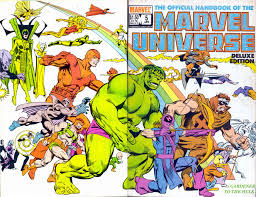The Official Handbook of the Marvel Universe Deluxe Edition- this day, 1985!
Thirty three years ago, today! (That is, August 27th, 1985)
Oh, the stories these opened up for me.
Alphabetically, fans could find every character still living who'd made at least three appearances, as well as many brand new lights.
Origins, major life events, stories from twenty-five years of great Marvel continuity. You could even find out how tall, how heavy, or what color eyes the character should have, which sort of personalizes them and makes them all the more easy to imagine.
You could find some description of every single power a character has, and often, see an Eliot R. Brown- illustrated blueprint for their best known weapons, vehicles, and acoutrement.
But what could ever be more fuel for debate than : STrength Level!
I was eleven when the series started, so of course I still found this part cool and interesting. Fans have been debating the strength levels of their favorite heroes and villains since comics began, so here was the sometimes controversial but always fun assessment of who could pick up what.
Yes, I loved seeing characters I knew so well, but, take this installment, the A's in issue #1 : I knew not half of 'em.
All I really knew were the old cartoons (which were real comics stories, awesome) and whatever I'd picked up from my year and a half as a collector. So here was my first look at menaces like Abomination, Arnim Zola- and many other characters popular in the 1970s stories I had never seen anywhere. But then, as the series progresses, you get the latest take on cool Kirby designs like The Eternals' Makkari and Ikaris. You don't know their stories, but as you read, the potential for any of them to be really awesome is all you know!
But pieces of the entire Marvel U began connecting, and as the series continued, you could cross-reference. You were encouraged, really, to look up everyone mentioned in the bios. There was no way, so long as I had the dough, I wasn't going to collect each and every one. Plus, it was a great way to get the iconic look of a character, or their newest costume, almost every one of the inked by the gold standard of 80's Marvel inking, Mr. Josef Rubinstein. Art was usually provided by the creator most associated with them, or whoever was the contemporary artist. You've got great figures by Jim Starlin, John Byrne, and the usual gang of suspects, when you talk 80's comics drawing. His Polaris was Marc Silverstri's first foray into drawing X-Men, that I know.
AS for characters without a regular artist, so many of them were rendered by Kevin Maguire. Kevin went on to DC's Justice League with his gift for making characters realistic in their body language and facial expressions. Such humanity and sly bits of humor.
Somehow, even the lamer characters who populated issue one seemed full of potential. It goes to show, it's the creator and the story they choose and the way they tell it, that really separates the wheat from the chaff.
It was a definitive work of the Marvel Universe, without being a story- or even a comic book- at all!
Looking back, it's most of all a snap shot of where the Marvel Universe was at this time. Just give a glance at the Book of the Dead issues at the end. The drama with which many of these characters made their bow and left the stage was robbed by resurrection. It's not like they weren't trying to be careful in the distinction either! The rules were, as I recall:
1) did you see a body?
2) were they pronounced dead by a reliable source? Ben Grimm was given as an example of a guy who maybe, just mebbe, could've mistaken a villain for dead because hey, he looks dead. But they are often very weird beings with different parameters. It'd be a kick to find these and flip them through, looking for who's turned up alive again. Why would they? A story called.
Even the index was good. A wallopin' sprawling work, from the studious mind of Peter Sanderson (and the indispensible editing of the perfect guy for that job, Mark Gruenwald). Yeah, it's even geekier than the comics themselves. You could buy a comic book now and then, or even collect a series, and so long as you had other interests, no big, just a fun past time. If you were collecting this series, however, you were hardcore!
I had not been collecting monthly two years yet, and what a great accounting of the story that was the continuous Marvel Universe.













Comments
Post a Comment